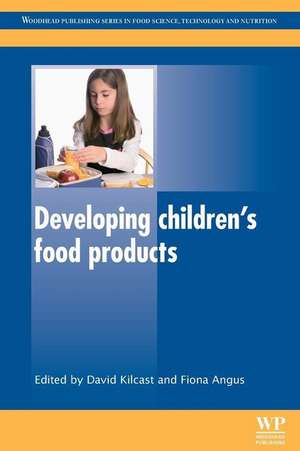Developing Children’s Food Products: Woodhead Publishing Series in Food Science, Technology and Nutrition
Editat de David Kilcast, Fiona Angusen Limba Engleză Paperback – 18 aug 2016
- Covers topical issues in pre-adult nutrition and health, discussing diet and behaviour and growing health problems such as childhood obesity and food allergies
- Reviews children’s food choices, addressing food promotion and food choice in children and strategies that can be used to improve children’s food choices
- Considers the design of food and drink products for children, with an emphasis on working with children and how best to undertake testing
Din seria Woodhead Publishing Series in Food Science, Technology and Nutrition
- 15%
 Preț: 391.19 lei
Preț: 391.19 lei -
 Preț: 800.10 lei
Preț: 800.10 lei - 24%
 Preț: 1333.02 lei
Preț: 1333.02 lei - 24%
 Preț: 1210.03 lei
Preț: 1210.03 lei - 24%
 Preț: 1189.10 lei
Preț: 1189.10 lei - 9%
 Preț: 1205.99 lei
Preț: 1205.99 lei - 24%
 Preț: 946.43 lei
Preț: 946.43 lei - 9%
 Preț: 1006.66 lei
Preț: 1006.66 lei - 9%
 Preț: 984.09 lei
Preț: 984.09 lei - 24%
 Preț: 960.56 lei
Preț: 960.56 lei - 23%
 Preț: 1419.50 lei
Preț: 1419.50 lei - 9%
 Preț: 922.07 lei
Preț: 922.07 lei - 24%
 Preț: 1192.22 lei
Preț: 1192.22 lei - 9%
 Preț: 1215.75 lei
Preț: 1215.75 lei - 24%
 Preț: 1162.37 lei
Preț: 1162.37 lei - 9%
 Preț: 950.09 lei
Preț: 950.09 lei - 24%
 Preț: 1162.62 lei
Preț: 1162.62 lei - 24%
 Preț: 801.31 lei
Preț: 801.31 lei - 27%
 Preț: 379.84 lei
Preț: 379.84 lei - 24%
 Preț: 798.74 lei
Preț: 798.74 lei - 29%
 Preț: 1336.07 lei
Preț: 1336.07 lei - 9%
 Preț: 1206.85 lei
Preț: 1206.85 lei - 9%
 Preț: 1018.93 lei
Preț: 1018.93 lei - 24%
 Preț: 1081.43 lei
Preț: 1081.43 lei - 24%
 Preț: 1185.22 lei
Preț: 1185.22 lei - 24%
 Preț: 1131.77 lei
Preț: 1131.77 lei - 23%
 Preț: 1635.86 lei
Preț: 1635.86 lei - 9%
 Preț: 1277.62 lei
Preț: 1277.62 lei - 24%
 Preț: 1049.04 lei
Preț: 1049.04 lei - 24%
 Preț: 1134.60 lei
Preț: 1134.60 lei - 9%
 Preț: 1076.36 lei
Preț: 1076.36 lei - 24%
 Preț: 1158.21 lei
Preț: 1158.21 lei - 9%
 Preț: 1065.06 lei
Preț: 1065.06 lei - 9%
 Preț: 1067.39 lei
Preț: 1067.39 lei - 24%
 Preț: 812.03 lei
Preț: 812.03 lei - 9%
 Preț: 1203.13 lei
Preț: 1203.13 lei - 23%
 Preț: 1237.19 lei
Preț: 1237.19 lei - 24%
 Preț: 948.79 lei
Preț: 948.79 lei - 23%
 Preț: 1138.06 lei
Preț: 1138.06 lei - 9%
 Preț: 868.43 lei
Preț: 868.43 lei - 24%
 Preț: 871.98 lei
Preț: 871.98 lei - 20%
 Preț: 1272.59 lei
Preț: 1272.59 lei - 29%
 Preț: 1195.06 lei
Preț: 1195.06 lei - 31%
 Preț: 922.77 lei
Preț: 922.77 lei - 9%
 Preț: 1045.58 lei
Preț: 1045.58 lei - 9%
 Preț: 1002.45 lei
Preț: 1002.45 lei - 9%
 Preț: 505.72 lei
Preț: 505.72 lei - 9%
 Preț: 1062.13 lei
Preț: 1062.13 lei
Preț: 811.17 lei
Preț vechi: 891.40 lei
-9% Nou
Puncte Express: 1217
Preț estimativ în valută:
155.22€ • 169.13$ • 130.79£
155.22€ • 169.13$ • 130.79£
Carte tipărită la comandă
Livrare economică 17 aprilie-01 mai
Preluare comenzi: 021 569.72.76
Specificații
ISBN-13: 9780081014929
ISBN-10: 0081014929
Pagini: 264
Dimensiuni: 156 x 234 x 14 mm
Greutate: 0.37 kg
Editura: ELSEVIER SCIENCE
Seria Woodhead Publishing Series in Food Science, Technology and Nutrition
ISBN-10: 0081014929
Pagini: 264
Dimensiuni: 156 x 234 x 14 mm
Greutate: 0.37 kg
Editura: ELSEVIER SCIENCE
Seria Woodhead Publishing Series in Food Science, Technology and Nutrition
Cuprins
Contributor contact details
Woodhead Publishing Series in Food Science, Technology and Nutrition
Preface
Part I: Pre-adult nutrition and health
Chapter 1: Children’s dietary needs: nutrients, interactions and their role in health
Abstract:
1.1 Introduction
1.2 Children’s basic nutrient requirements: an overview of macro- and micronutrients
1.3 Determinants of adequate nutrient intake in children
1.31 Growth and development
1.4 Developmental considerations in children’s dietary needs
1.5 Children’s dietary quality and its impact on well-being
1.6 Implications of children’s nutrient requirements for the food industry, healthcare professionals and policy makers
1.7 Future trends
Chapter 2: Fluids and children’s health
Abstract:
2.1 Introduction
2.2 Typical beverage intake in children: data and trends from Germany
2.3 Implications of typical beverage intake in children for food industry, healthcare professionals and policy makers
2.4 Future trends
Chapter 3: Childhood obesity: the contribution of diet
Abstract:
3.1 Introduction
3.2 Trends in childhood obesity
3.3 Impact of childhood obesity on children’s health and later life
3.4 Implications of childhood obesity for the food industry, healthcare professionals and policy makers
3.5 Future trends
Chapter 4: Diet, behaviour and cognition in children
Abstract:
4.1 Introduction
4.2 Essential fatty acids in children’s diets
4.3 Vitamins and minerals in children’s diets
4.4 Behavioural problems in children resulting from diet
4.5 The nature of meals and their impact on diet, behaviour and cognition in children
4.6 The impact of hydration on diet, behaviour and cognition in children
4.7 Implications of trends in children’s diet for the food industry, heathcare professionals and policy makers
4.8 Future trends
Chapter 5: Food allergies and food intolerances in children
Abstract:
5.1 Introduction
5.2 What are food allergies and intolerances?
5.3 Prevalence of food allergies and intolerances in children
5.4 Impact of food allergies and intolerances on children’s health and quality of life
5.5 Role of foods in the development and management of allergies and intolerances
5.6 Implications of food allergies and intolerances in children for the food industry, healthcare professionals and policy makers
5.7 Future trends
5.8 Sources of further information and advice
Part II: Children’s food choices
Chapter 6: Food promotion and food choice in children
Abstract:
6.1 Introduction to food promotion aimed at children
6.2 The extent and nature of food promotion to children
6.3 The effects of food promotion to children
6.4 Implications for the food industry, healthcare professionals and policy makers: regulation of food marketing activity
6.5 Summary
Chapter 7: Increasing children’s food choices: strategies based upon research and practice
Abstract:
7.1 Introduction
7.2 The role of exposure in the development of taste preferences in children
7.3 Modifying foods to improve their acceptance and consumption by children
7.4 Reinforcement-based interventions used for increasing acceptance of novel foods by children
7.5 Family influences on children’s food choice
7.6 Conclusion
Chapter 8: School-based interventions to improve children’s food choices: the Kid’s choice program
Abstract:
8.1 Introduction
8.2 School-based interventions to improve children’s food choices: components suggested by theory and past research
8.3 Focused review of school-based interventions to improve children’s food choices: the Kid’s choice program
Part III: Design of food and drink products for children
Chapter 9: Consumer testing of food products using children
Abstract:
9.1 Introduction
9.2 Sensory perception: sensitivity and perceived intensity
9.3 The origin of food preferences
9.4 Difference between children and adults in food preferences
9.5 Research methods for consumer testing of food products for children
9.6 Hedonic testing with children
9.7 Use of intensity and just-about-right scales
9.8 Future trends
Chapter 10: Case studies of consumer testing of food products using children
Abstract:
10.1 Introduction
10.2 Case study 1: consumer research under standardised conditions
10.3 Case study 2: consumer research using children at school
10.4 Conclusions
Chapter 11: Working with children and adolescents for food product development
Abstract:
11.1 Planning and creating for the future: why consumer and industry demands will require us to unleash the power of genuine consumer connectedness in new product development
11.2 Setting the scene: understanding the importance of a holistic approach to building brands and products, particularly for young customers
11.3 Ages and stages: the importance to new product development for kids of understanding basic child development. A brief review of key underlying drivers, including neophobia, and how these can be best utilized in connecting kids to the product development process
11.4 Implications for testing: some thoughts on taking sensory evaluation and other aspects of product testing to the next level with kids
Index
Woodhead Publishing Series in Food Science, Technology and Nutrition
Preface
Part I: Pre-adult nutrition and health
Chapter 1: Children’s dietary needs: nutrients, interactions and their role in health
Abstract:
1.1 Introduction
1.2 Children’s basic nutrient requirements: an overview of macro- and micronutrients
1.3 Determinants of adequate nutrient intake in children
1.31 Growth and development
1.4 Developmental considerations in children’s dietary needs
1.5 Children’s dietary quality and its impact on well-being
1.6 Implications of children’s nutrient requirements for the food industry, healthcare professionals and policy makers
1.7 Future trends
Chapter 2: Fluids and children’s health
Abstract:
2.1 Introduction
2.2 Typical beverage intake in children: data and trends from Germany
2.3 Implications of typical beverage intake in children for food industry, healthcare professionals and policy makers
2.4 Future trends
Chapter 3: Childhood obesity: the contribution of diet
Abstract:
3.1 Introduction
3.2 Trends in childhood obesity
3.3 Impact of childhood obesity on children’s health and later life
3.4 Implications of childhood obesity for the food industry, healthcare professionals and policy makers
3.5 Future trends
Chapter 4: Diet, behaviour and cognition in children
Abstract:
4.1 Introduction
4.2 Essential fatty acids in children’s diets
4.3 Vitamins and minerals in children’s diets
4.4 Behavioural problems in children resulting from diet
4.5 The nature of meals and their impact on diet, behaviour and cognition in children
4.6 The impact of hydration on diet, behaviour and cognition in children
4.7 Implications of trends in children’s diet for the food industry, heathcare professionals and policy makers
4.8 Future trends
Chapter 5: Food allergies and food intolerances in children
Abstract:
5.1 Introduction
5.2 What are food allergies and intolerances?
5.3 Prevalence of food allergies and intolerances in children
5.4 Impact of food allergies and intolerances on children’s health and quality of life
5.5 Role of foods in the development and management of allergies and intolerances
5.6 Implications of food allergies and intolerances in children for the food industry, healthcare professionals and policy makers
5.7 Future trends
5.8 Sources of further information and advice
Part II: Children’s food choices
Chapter 6: Food promotion and food choice in children
Abstract:
6.1 Introduction to food promotion aimed at children
6.2 The extent and nature of food promotion to children
6.3 The effects of food promotion to children
6.4 Implications for the food industry, healthcare professionals and policy makers: regulation of food marketing activity
6.5 Summary
Chapter 7: Increasing children’s food choices: strategies based upon research and practice
Abstract:
7.1 Introduction
7.2 The role of exposure in the development of taste preferences in children
7.3 Modifying foods to improve their acceptance and consumption by children
7.4 Reinforcement-based interventions used for increasing acceptance of novel foods by children
7.5 Family influences on children’s food choice
7.6 Conclusion
Chapter 8: School-based interventions to improve children’s food choices: the Kid’s choice program
Abstract:
8.1 Introduction
8.2 School-based interventions to improve children’s food choices: components suggested by theory and past research
8.3 Focused review of school-based interventions to improve children’s food choices: the Kid’s choice program
Part III: Design of food and drink products for children
Chapter 9: Consumer testing of food products using children
Abstract:
9.1 Introduction
9.2 Sensory perception: sensitivity and perceived intensity
9.3 The origin of food preferences
9.4 Difference between children and adults in food preferences
9.5 Research methods for consumer testing of food products for children
9.6 Hedonic testing with children
9.7 Use of intensity and just-about-right scales
9.8 Future trends
Chapter 10: Case studies of consumer testing of food products using children
Abstract:
10.1 Introduction
10.2 Case study 1: consumer research under standardised conditions
10.3 Case study 2: consumer research using children at school
10.4 Conclusions
Chapter 11: Working with children and adolescents for food product development
Abstract:
11.1 Planning and creating for the future: why consumer and industry demands will require us to unleash the power of genuine consumer connectedness in new product development
11.2 Setting the scene: understanding the importance of a holistic approach to building brands and products, particularly for young customers
11.3 Ages and stages: the importance to new product development for kids of understanding basic child development. A brief review of key underlying drivers, including neophobia, and how these can be best utilized in connecting kids to the product development process
11.4 Implications for testing: some thoughts on taking sensory evaluation and other aspects of product testing to the next level with kids
Index





